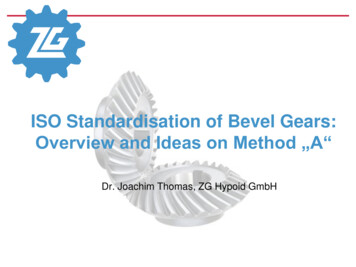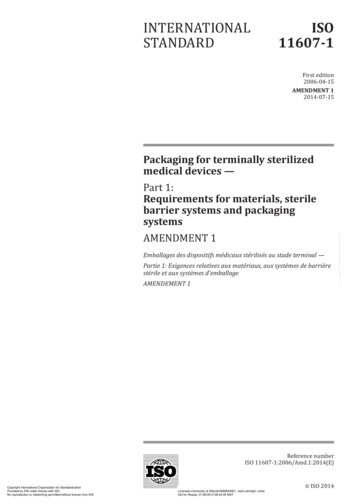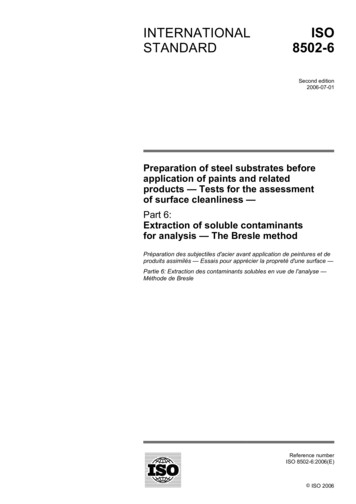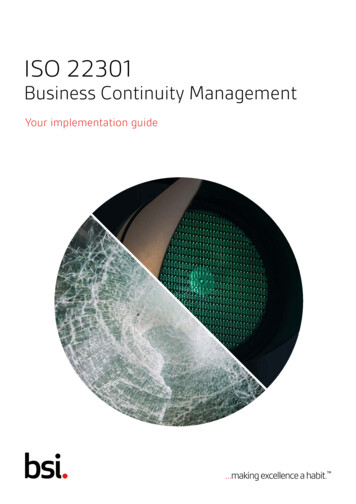
Transcription
INTERNATIONALSTANDARDISO10993-1Fourth edition2009-10-15Biological evaluation of medicaldevices —Part 1:Evaluation and testing within a riskmanagement processÉvaluation biologique des dispositifs médicaux —Partie 1: Évaluation et essais au sein d'un processus de gestiondu risqueReference numberISO 10993-1:2009(E) ISO 2009
ISO 10993-1:2009(E)PDF disclaimerThis PDF file may contain embedded typefaces. In accordance with Adobe's licensing policy, this file may be printed or viewed butshall not be edited unless the typefaces which are embedded are licensed to and installed on the computer performing the editing. Indownloading this file, parties accept therein the responsibility of not infringing Adobe's licensing policy. The ISO Central Secretariataccepts no liability in this area.Adobe is a trademark of Adobe Systems Incorporated.Details of the software products used to create this PDF file can be found in the General Info relative to the file; the PDF-creationparameters were optimized for printing. Every care has been taken to ensure that the file is suitable for use by ISO member bodies. Inthe unlikely event that a problem relating to it is found, please inform the Central Secretariat at the address given below.COPYRIGHT PROTECTED DOCUMENT ISO 2009All rights reserved. Unless otherwise specified, no part of this publication may be reproduced or utilized in any form or by any means,electronic or mechanical, including photocopying and microfilm, without permission in writing from either ISO at the address below orISO's member body in the country of the requester.ISO copyright officeCase postale 56 CH-1211 Geneva 20Tel. 41 22 749 01 11Fax 41 22 749 09 47E-mail copyright@iso.orgWeb www.iso.orgPublished in Switzerlandii ISO 2009 – All rights reserved
ISO 10993-1:2009(E)ContentsPageForeword .ivIntroduction.vi1Scope .12Normative references.13Terms and definitions .24General principles applying to biological evaluation of medical devices.355.15.25.3Categorization of medical devices .6General .6Categorization by nature of body contact .6Categorization by duration of contact.766.16.2Biological evaluation process.8Material characterization .8Biological evaluation tests .87Interpretation of biological evaluation data and overall biological safety assessment .14Annex A (informative) Biological evaluation tests .15Annex B (informative) Guidance on the risk management process .16Annex C (informative) Suggested procedure for literature review .19Bibliography.21 ISO 2009 – All rights reservediii
ISO 10993-1:2009(E)ForewordISO (the International Organization for Standardization) is a worldwide federation of national standards bodies(ISO member bodies). The work of preparing International Standards is normally carried out through ISOtechnical committees. Each member body interested in a subject for which a technical committee has beenestablished has the right to be represented on that committee. International organizations, governmental andnon-governmental, in liaison with ISO, also take part in the work. ISO collaborates closely with theInternational Electrotechnical Commission (IEC) on all matters of electrotechnical standardization.International Standards are drafted in accordance with the rules given in the ISO/IEC Directives, Part 2.The main task of technical committees is to prepare International Standards. Draft International Standardsadopted by the technical committees are circulated to the member bodies for voting. Publication as anInternational Standard requires approval by at least 75 % of the member bodies casting a vote.Attention is drawn to the possibility that some of the elements of this document may be the subject of patentrights. ISO shall not be held responsible for identifying any or all such patent rights.ISO 10993-1 was prepared by Technical Committee ISO/TC 194, Biological evaluation of medical devices.This fourth edition cancels and replaces the third edition (ISO 10993-1:2003), which has been technicallyrevised.ISO 10993 consists of the following parts, under the general title Biological evaluation of medical devices: Part 1: Evaluation and testing within a risk management process Part 2: Animal welfare requirements Part 3: Tests for genotoxicity, carcinogenicity and reproductive toxicity Part 4: Selection of tests for interactions with blood Part 5: Tests for in vitro cytotoxicity Part 6: Tests for local effects after implantation Part 7: Ethylene oxide sterilization residuals Part 9: Framework for identification and quantification of potential degradation products Part 10: Tests for irritation and skin sensitization Part 11: Tests for systemic toxicity Part 12: Sample preparation and reference materials Part 13: Identification and quantification of degradation products from polymeric medical devices Part 14: Identification and quantification of degradation products from ceramics Part 15: Identification and quantification of degradation products from metals and alloysiv ISO 2009 – All rights reserved
ISO 10993-1:2009(E) Part 16: Toxicokinetic study design for degradation products and leachables Part 17: Establishment of allowable limits for leachable substances Part 18: Chemical characterization of materials Part 19: Physico-chemical, morphological and topographical characterization of materials (TechnicalSpecification) Part 20: Principles and methods for immunotoxicology testing of medical devices (TechnicalSpecification)Future parts will deal with other relevant aspects of biological evaluation. ISO 2009 – All rights reservedv
ISO 10993-1:2009(E)IntroductionThe primary aim of this part of ISO 10993 is the protection of humans from potential biological risks arisingfrom the use of medical devices. It is compiled from numerous International and National Standards andGuidelines concerning the biological evaluation of medical devices. It is intended to be a guidance documentfor the biological evaluation of medical devices within a risk management process, as part of the overallevaluation and development of each device. This approach combines the review and evaluation of existingdata from all sources with, where necessary, the selection and application of additional tests, thus enabling afull evaluation to be made of the biological responses to each medical device, relevant to its safety in use. Itmust be appreciated that the term “medical device” is wide-ranging and, at one extreme, consists of a singlematerial, which may exist in more than one physical form, and at the other extreme, of a complex instrumentor piece of apparatus, consisting of numerous components made of more than one material.ISO 10993 addresses the determination of the effects of medical devices on tissues, mostly in a general way,rather than in a specific device-type situation. Thus, for a complete biological safety evaluation, it classifiesmedical devices according to the nature and duration of their anticipated contact with human tissues when inuse and indicates, in matrices, the biological data sets that are thought to be relevant in the consideration ofeach device category.The range of biological hazards is wide and complex. The tissue interaction with a constituent material alonecannot be considered in isolation from the overall device design. Thus, in designing a device, the choice of thebest material with respect to its tissue interaction might result in a less functional device, tissue interactionbeing only one of a number of characteristics to be considered in making that choice. Where a material isintended to interact with tissue in order to perform its function, the biological evaluation needs to address this.Tissue interactions that are regarded as adverse, caused by a material in one application, might not beregarded as such in a different situation. Biological testing is based upon, among other things, in vitro and exvivo test methods and upon animal models, so that the anticipated behaviour when a device is used inhumans can be adjudged only with caution, as it cannot be unequivocally concluded that the same tissuereactions will also occur in this species. In addition, differences in the manner of response to the samematerial among individuals indicate that some patients can have adverse reactions, even to well-establishedmaterials.The role of this part of ISO 10993 is to serve as a framework in which to plan a biological evaluation which, asscientific knowledge advances our understanding of the basic mechanisms of tissue responses, minimizes thenumber and exposure of test animals by giving preference to chemical constituent testing and in vitro models,in situations where these methods yield equally relevant information to that obtained from in vivo models.It is not intended that ISO 10993 provide a rigid set of test methods, including pass/fail criteria, as this mightresult in either an unnecessary constraint on the development and use of novel medical devices, or a falsesense of security in the general use of medical devices. Where a particular application warrants it, experts inthe product or in the area of application concerned can choose to establish specific tests and criteria,described in a product-specific vertical standard.This part of ISO 10993 is intended for use by professionals, appropriately qualified by training and experience,who are able to interpret its requirements and judge the outcome of the evaluation for each medical device,taking into consideration all the factors relevant to the device, its intended use and the current knowledge ofthe medical device provided by review of the scientific literature and previous clinical experience.Annex A contains an informative table that is generally helpful in identifying biological data sets recommendedin the evaluation of medical devices, according to their category of body contact and duration of clinicalexposure. Annex B contains guidance for the application of the risk management process to medical deviceswhich encompasses biological evaluation.vi ISO 2009 – All rights reserved
INTERNATIONAL STANDARDISO 10993-1:2009(E)Biological evaluation of medical devices —Part 1:Evaluation and testing within a risk management process1ScopeThis part of ISO 10993 describes: the general principles governing the biological evaluation of medical devices within a risk managementprocess; the general categorization of devices based on the nature and duration of their contact with the body; the evaluation of existing relevant data from all sources; the identification of gaps in the available data set on the basis of a risk analysis; the identification of additional data sets necessary to analyse the biological safety of the medical device; the assessment of the biological safety of the medical device.This part of ISO 10993 does not cover testing of materials and devices that do not come into direct or indirectcontact with the patient's body, nor does it cover biological hazards arising from any mechanical failure. Otherparts of ISO 10993 cover specific tests, as indicated in the Foreword.2Normative referencesThe following documents are indispensable for the application of this document. For dated references, onlythe edition cited applies. For undated references, the latest edition of the referenced document (including anyamendments) applies.ISO 10993-2, Biological evaluation of medical devices — Part 2: Animal welfare requirementsISO 10993-3, Biological evaluation of medical devices — Part 3: Tests for genotoxicity, carcinogenicity andreproductive toxicityISO 10993-4, Biological evaluation of medical devices — Part 4: Selection of tests for interaction with bloodISO 10993-5, Biological evaluation of medical devices — Part 5: Tests for in vitro cytotoxicityISO 10993-6, Biological evaluation of medical devices — Part 6: Tests for local effects after implantationISO 10993-7, Biological evaluation of medical devices — Part 7: Ethylene oxide sterilization residualsISO 10993-9, Biological evaluation of medical devices — Part 9: Framework for identification andquantification of potential degradation productsISO 10993-10, Bio
rights. ISO shall not be held responsible for identifying any or all such patent rights. ISO 10993-1 was prepared by Technical Committee ISO/TC 194, Biological evaluation of medical devices. This fourth edition cancels and replaces the third edition (ISO 10993-1:2003), which has been technically revised.










